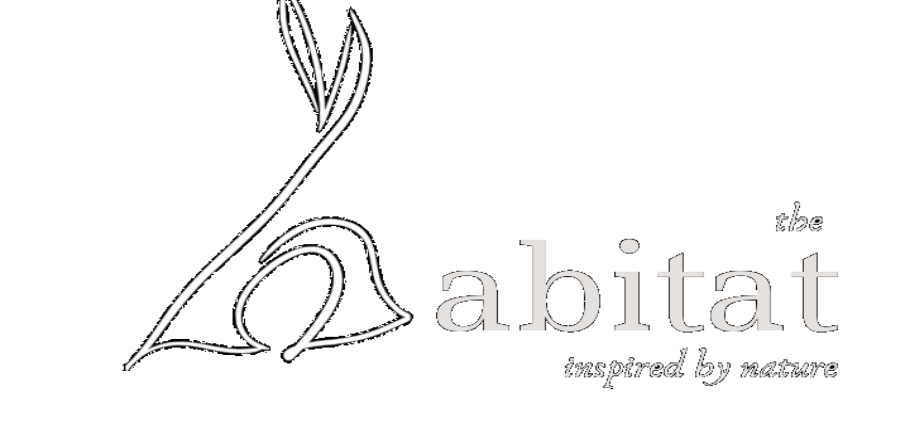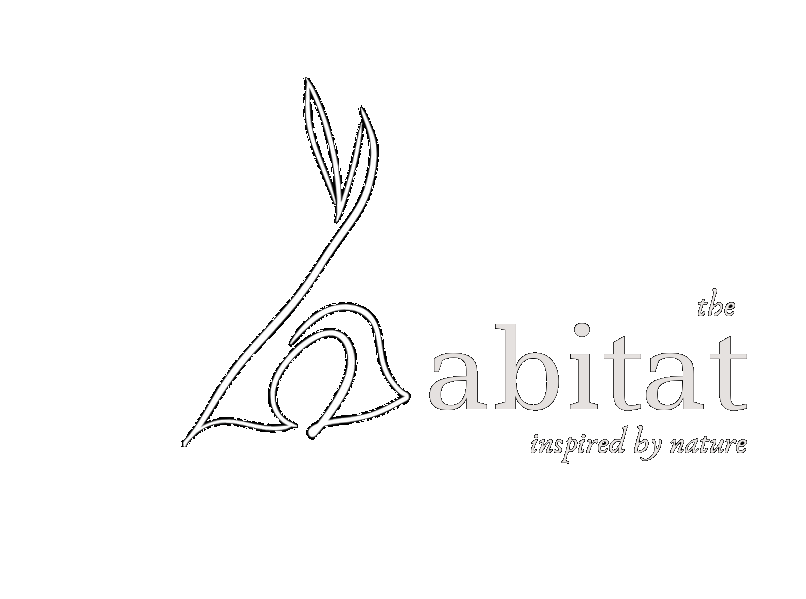invitation into wilderness
Let´s create a Foodforest
go back to your roots
we humans must become mindful
The Center
What´s a
Foodforest
A food forest is an independent, self-sustaining and sustainable ecosystem that supplies animals, bacteria and people with food. In addition to various fruit trees and pure, tall deciduous trees, shrubs and many herbs, vines and pumpkins, there are also different types of vegetables in such a food forest. In harmony between humans, animals and nature, a sustainable, self-regenerating and healthy cycle is created. A food forest shows you the way to a conscious handling of food and its diversity, which you can create. Would you like to know more about the different layers of the food forest and its structure? Learn how to extract compost and humus? Or how you can produce your own biochar and create your own holistic little ecosystem?
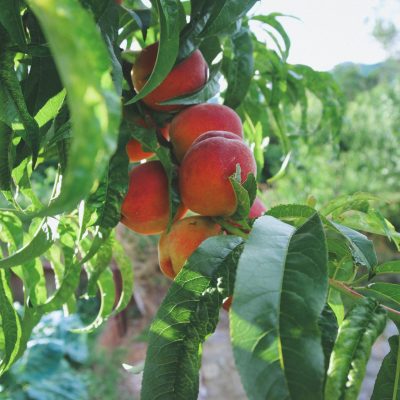

The
Emergance
Walking through a forest of fruits hanging at eye level. The ground is full of wild herbs. The scent and the humid cool air that surrounds you. The many creatures that use this Area as their habitat. The harmony between nature and human as a guest, exactly this is what we want to create .
Stop the devastation
Start Planting
Subscribe for the weekly Newsletter an follow us on
The
Forest
There are 4 levels that are supported by dry stone walls and have a total size of 4500 square meters. Each level is lined with trees, shrubs and herbs. The treas are importent to ceate shadow Roof for the Soil and other baby Fruit Trees. This Roof will hold the temperature down inside the Foodforest and keeps the water back in this microzone. Between this Fruit Trees we use the space for Beery-Shrubs, Flowers, green fertilizer like Sinapis arvensis or diverent Sativas. This helps the earth to change from a loam structure to a loose, humus-rich mass. This is the irreplaceable habitat for microorganisms, microorganisms, insects, reptiles and rodents. This cycle helps to create a healthy ecosystem where you can grow healthy and sustainable food without pesticides or other unnatural practices
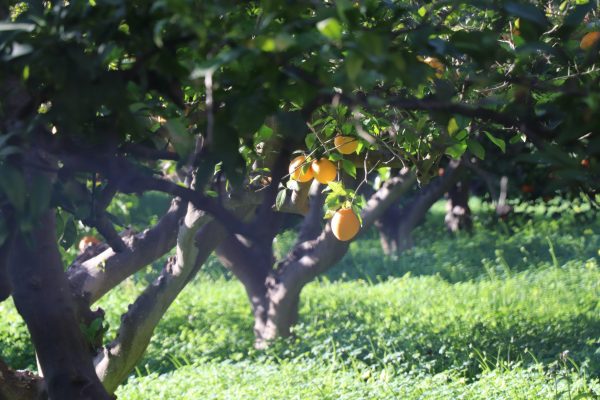

The important of an
Forest
The forests with a high density of plants ensure correspondingly high yields in the smallest of spaces
The resulting biological diversity ensures a continuous supply of fruit, berries, teas, flowers, vegetables, herbs and spices all year round.
As in natural forests, a fully-grown food forest is largely self-fertilized and covers the soil independently of one another in order to store the moisture that is essential for survival.
With such a high density of plants, a large volume of fallen leaves will accumulate and turn red to add fresh organic matter to the soil.
A large number of animals find their new habitat here and keep the ecosystem in balance. Decomposers, the class of insects that break down organic matter such as earthworms, wood lice (pill bugs, slater) and millipedes, support the natural composting process.
It takes place natural pest control due to the large number of animals
This means no chemicals are needed and a balance is established. Natural predators also settle there to get rid of pests.
No chemicals are required! Food forests use natural predators to get rid of pests – and let the experts do their job naturally.
Predatory insects find their permanent home in this natural, balanced ecosystem. Bees, bumblebees and butterflies also find plenty of food sources in nectar-rich flowers and vegetables and contribute to pollination. A conventional vegetable patch is often a home for only one species, namely the pests, there is no place where good beetles can live!
An abundant living ecosystem also attracts many birds and other larger predators, helping to combat pests naturally.
As in “wild” emerging forests, nature does not grow any mono plant species. It also does not reproduce in correct rows. Nature prefers biological diversity and not monocultures! By mixing many different types of plants, they will all grow better together. A natural synergy is created that benefits all plants involved. As a result, the plants are not only more resistant to pests and diseases and more productive, but the variety is also much nicer to look at.
Using companion plants enables us to restore nature’s biodiversity to achieve precisely these benefits.
When plants naturally die off, they stay in place. You will not be uprooted like in a traditional garden! We try to let nature work and do not uproot plants that cannot cause damage, but cut the stem at ground level. The remaining roots rot under the soil and form thousands of complex air and water channels in the soil. The trimmed tips of the chopped plants form a natural compost system like the natural forest soil exemplifies.
Every soil is alive. It is up to us to revitalize it and to keep the complex ecosystem alive and to benefit from it. Everything that exists above ground also contributes to a balance underground. Entering the garden beds compacts the soil, closes all air and water ducts and makes it difficult for water and air to reach plant roots, which affects plant growth.
Stop the devastation
Soil
is
Life
The 7 Main Layers of our
Foodforest
I this layer the goal is to create the most possible shadow in the midsun to protect the trees growing underneath. In our case, these trees are mostly high growing (up to 15 Meters) leaf trees to give the soil the necessary mulching. Timber, high nut and nitrogen-fixing trees are typical in this layer.
As a protection against strong winds and as an important nitrogen supplier, they are the ideal partners for the more sensitive fruit tree layer
Most of it can be seen and admired on this level. Typically 3-5 meter high fruit trees show the picture of this level. We have chosen a variety of different fruit trees for this level. These can produce their fruits in this protected environment.
Due to the light shade and the wind protection of the layer above, the fruit stands cannot be damaged by wind and weather. This layer is also responsible for storing the vaporized water.
All kinds of various fruit and tea bushes fall into this layer. with a typical height of max. 3 meters, this layer can be laid out individually according to the presence and space. We have distributed various berry and tea bushes over the plains. Some flower-bearing shrubs as well as typical shrub-forming spices and flowers complete this layer
This layer can contain all kinds of more vegetables. Small growing spices and large herbs also belong in here. We decided on a wide variety of combinations of herbs and vegetables that occupy a safe place between the trees and bushes on the slope.
These beds are easily accessible and this layer grows wonderfully in the fertile soil protected and fertilized by the trees.
Theire is a overlap with the Herbaceous and Groundcover Layer.
The main task of this level is to protect the soil from drying out and to hold back all water and ensure a healthy earth climate. It fills gaps in the forest and some parts tolerates foot traffic
This layer is the home of the root crops. There is a great variety of edible roots that many people are not yet aware of. Particularly old root vegetables that have been forgotten find their place here. Many of these plants can be used in the herb, grapevine / climbing layer, and ground cover / creeping layer.
These vine and climbing plants grow vertically over several layers, depending on how they are trained and directed. They are a great way to get greater productivity in a small space. Pergolas scaffolding and different trunks of trees are used as climbing aids to the same extent and depending on their accessibility for harvesting
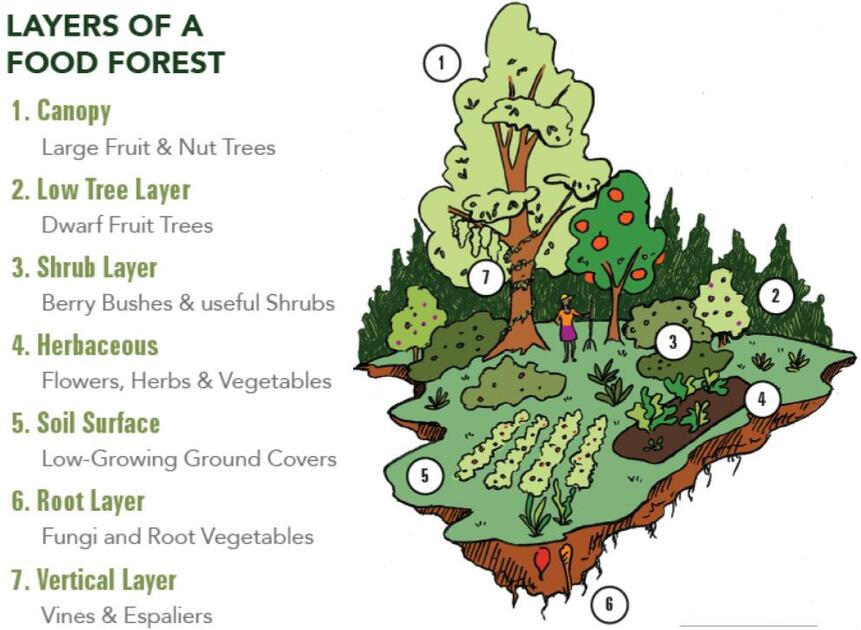
The
Plant Guide
If you imagine such a food forest as a whole unit, then a plant guild is a sub-unit.These different plant guilds consist of a collection of different plants that are coordinated with each other and help each other to grow and survive. These are often identified by a central dominant tree.All plants grow naturally with other species in nature and not in individual monoculture-like species groups separately from one another. The aim of forming plant guilds is to allow plants to grow naturally in harmony with one another, taking into account how they can best help people.A plant guild is a group of plants that like to grow together because they help and support each other in their community. These groups of plants also benefit humans. These plant guilds can consist of the following types of plants: tall trees, small trees, bushes, vines, root plants, ground cover plants, water-edge plants and mushrooms.
Within the group, this variety of plants serves different purposes. All of this happens on the basis of permaculture
Our diverent
Plants
This genus of plants can be found in every layer of the food forest and attracts bees, bumblebees and a large number of other insects, which ensure the fertilization of the most diverse flowers and thus help with the fruit and natural seed formation.
These plants are responsible for the production of the vital nitrogen and give the soil important nutrients. these in turn are important to support the plants in their growth and to keep the leaves green
This plant genus draws many nutrients dormant deep in the earth to the surface and stores them for the young roots of the young plants. With their help, water is also stored, retained and transported into the upper layers. This is the battery of the food forest in the dry season
Plants with a high proportion of essential oils or fragrance-forming substances help us to keep pests away from sensitive groups of plants and contribute to the whole. Insects that can harm fruits and vegetables are repelled naturally and without cemicals
These are the main producers in our food forest and provide us all year round with delicacies that nature has in store for us. Whether fruit trees or berry bushes. There are no limits to the variety.
Medicinal herbs and teas play a key role in human history and have been grown and processed in every culture and across the globe. Why not create your own medicinal herb garden and process it. In addition, there is nothing better than sitting in front of the fireplace with a good cup of tea in winter and enjoying the fruits of your seasonal Work.
The most natural thing about fertilization is the possible green manure. A wide variety of plant waste and the natural change of foliage caused by the seasons provide the humus and fertilizer for the next generation of plants, which provides strength in spring to help the food forest wake up again
© 2020, Habitat All rights reserved.
follow us
Composting&
Fertilizing
One of the most important issues for healthy soil is the composting of organic matter. We have created several composters for this purpose, which are filled with green waste, branches and kitchen waste. We also have dry toilets for our visitors, with which we can produce important nitrogenous fertilizers. This earth is added to the plants and trees as humus and fertilizer and gives nature the strength to grow



active coal production
sdfasdfasdfasdf
Compost Toilett
sdfasdfasdfasdf


The mission
What we do

recultivate
remove the monoculture and
restore growingzones

planing
Planing different growingzones based on permaculture

planting
The most beautiful work is planting and watch nature growing

water protection
We use the importent resource Water with care and try to protect it in the soil as possible we can
main INfo
Question & Answer
in the summer of 2019 we started to recultivate a land in a valley and make the soil fertile again. Around 5000 square metres of blackberries were removed. The old stock of citrus fruit trees was tended and the slopes were newly terraced.
There is a food forest with hundreds of different fruit trees that protect the earth from erosion and devastation. These trees provide the necessary protection from the sun. Herbs and fruits can grow below in the shrub level, protected from the heat. These also secure the slopes and serve as an important source of nitrogen as green manure for the vital humus. The resulting gaps are filled with vegetables to create a species-rich permaculture garden. The resulting microclimate keeps the moisture in the forest and releases it into the atmosphere to be absorbed by the leaves.
Our earth is very clayey due to the nature of the soil. The unprotected areas exposed to the sun are therefore very dry and lifeless in summer. Important microorganisms are missing to keep the earth alive.
This is why planting is all the more important to protect the earth and also to create a habitat for microorganisms and insects.
Only living soil is good soil
our fertilizer is made in different ways. On the one hand, important fertilizer arises from clippings that are left lying around and do their work as a foundation.
We use dry toilet toilets to compost human “waste” and return it to nature.
We also have chickens, goats and a donkey. These animals provide us with important manure that we incorporate into the composting process
xyyxx
The aim is to create a walkable, edible forest. We want to be able to provide for our guests and ourselves as much as possible. Our guests should hike through this forest and learn and find out more about the biodiversity from signs and descriptions.
Become a member
Sed ut perspiciatis unde omnis iste natus error sit voluptatem accusantium doloremque laudantium, totam rem aperiam, eaque ipsa.






